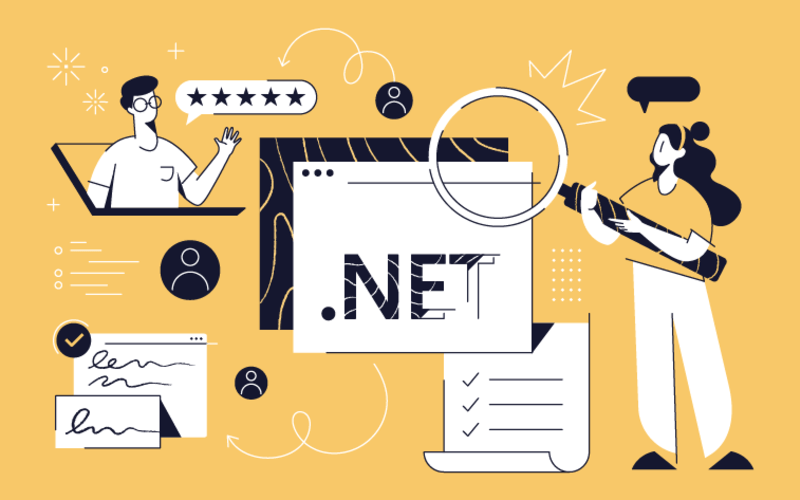NEW
Proxify is bringing transparency to tech team performance based on research conducted at Stanford. An industry first, built for engineering leaders.
Learn more
Hiring & Retention
Employer branding
Sep 05, 2022 · 10 min read
Tips for writing a Backend Developer job ad
Writing an efficient and on-point job ad is tricky, and you need to ensure all crucial information is presented accordingly and attracts the ideal candidate you need to engage as a backend developer.
Marija Neshkoska
Content Writer
Verified author

Table of Contents
- What is backend development precisely?
- Types of backend programming and programming languages
- Types of backend development skills
- An example of a backend developer job ad
- Job description
- About the company
- Responsibilities
- Requirements, skills, and expertise
- Nice-to-have skills or qualifications
- Availability, salary, and perks
- The takeaway
- Find a developer
You could think of this article as a clear, general direction to writing a concise job posting for backend devs. There is no one universal developer job description template, but there are some sections that you absolutely have to include.
If the job ad sounds a bit off – not informational enough, too short and missing crucial details, or too long and ‘intimidating’ – then it’s highly likely that you’ll face some challenging situations down the road. For example, good backend developers could skip your job ad completely. Possible challenges like this are a waste of time and resources, hindering the hiring process only because of a job ad that could have been formulated better.
Let’s see what sections you should include to create a “spot-on” job ad that attracts the best backend devs.
What is backend development precisely?
Web development encompasses different types of developers; fullstack, frontend, and backend – a web developer can fit one of these three types as mentioned above.
But even more precisely, both frontend and backend developers are software engineers.
Backend development means that all the work done is generally not seen on the website, i.e., working with server-side software and ensuring everything works well and correctly on the website “behind the scenes”. Utilizing backend logic, databases, and APIs, including working on the website’s architecture are the core things that would describe a backend dev.
Boost your team
Proxify developers are a powerful extension of your team, consistently delivering expert solutions. With a proven track record across 500+ industries, our specialists integrate seamlessly into your projects, helping you fast-track your roadmap and drive lasting success.
Types of backend programming and programming languages
Backend development programming can be categorized into:
- Functional
- OOP (Object-oriented programming)
With both of these categories, various programming languages are used accordingly.
Functional programming is an action-based technique with a declarative paradigm and is predominantly used in Data Science. The most popular programming languages in functional programming are R, F#, and SQL, among others. The statements in FP don’t need to be in any specific or determined order.
OOP is used when we create particular objects, but unlike functional programming, OOP developers must make every statement in a specific, determined order. The most popular languages used with OOP are .NET, Java, and Python.
Types of backend development skills
Apart from the most popular backend development languages, the backend dev would most likely need to have other skills too, such as working on/with:
-
Web servers – Every backend dev needs to know how to handle all HTTP components and proxies well, including Nginx load balancers. Web servers predominantly use HTTP , among other protocols.
-
API – When two separate apps communicate with each other, they do it through the Application Programming Interfaces. The majority of architectures for server-side software are built based on API principles.
-
Cache and databases – Mastering cache handling and databases is an advantageous asset to have as a backend dev. In fact, for most backend jobs, it’s expected that the dev is an expert in PostgreSQL, MySQL, SQL Server, Microsoft Access, and DBMS (Database Management Systems). Preferably, they should also have a master-level understanding of some caching principles, either with Memcached or Redis.
An example of a backend developer job ad
Here is a practical example of what each section in the backend dev job ad should contain.
Job description
In this opening section of the job ad, mention what role you are looking to fill and why. Mention the dynamics of the job position in context with your company, and note if the position is more akin to a group or individual type of work.
Briefly mention the most crucial obligations the job entails before you go to the next section. You can also mention working on websites, apps, and any technologies that are needed to accomplish specific aspects for the job.
And describe the impact/effect of the engagements assigned to the backend dev. At this point, you should grab the candidate’s attention.
Job description section example:
“Our company is looking for a Backend developer to join our dynamic IT team. The ideal candidate will help us with web apps and server management, as well as management of the exchanged data between users and servers. You will be a part of a progressive team, working closely with excellent and proven engineers on server-side logic and updating the apps we have built so far. You’ll also need to understand various frontend technologies to incorporate their elements where needed in the applications.”
About the company
Nothing describes the company culture as well as the ‘About’ section of the job ad. Try to avoid the sterile, “full-of-fluff” type of paragraphs here. Have your mission and goal for the company in mind when you create this ad section. Explain what motivates you to keep the competitive ‘drive’ and what defines the ‘edge’ that leads your business to succeed. What sort of benefit or change does the company bring to the market? Have these questions in mind when you’re writing the about section of the job advertisement.
Additionally, this paragraph should be short, concise, catchy, and informative, without many lengthy chunks of text.
In a few words, you can mention the following:
- What the company is all about
- The number of members and office locations (if applicable)
- What career development benefits will the job bring to the new team member
- The responsibilities that follow for the new member after the initial period is over (for example, building applications independently once they finish working on apps with others in the team, and similar projects)
Responsibilities
This section should clarify to the dev what will be expected of them. You should not leave room for extreme surprises, so be sure to mention all due obligations to avoid confusion or frustrations on both ends of the hiring parties down the road.
For example, you can mention:
- Development of automated tests
- Creating prototypes and codes and testing them
- Creating reusable code
- Creating solid APIs for both desktop and mobile
- Managing data and resolving data-related issues
- Using various data protection and security methods
- Improving the user experience
- Improving and optimizing web apps for better scalability
Requirements, skills, and expertise
This section lists keywords describing the dev’s experience and expertise. In the first two years of the career, devs are considered juniors, and anyone with more than five years of experience would be considered a senior dev. Regarding education, a BA degree in Computer Science is the universal minimum requirement. However, this section can have some wiggle room according to your business needs. There are quality self-taught devs who excel at their job just as much as their college graduate peers.
In this section, mention the years of experience, the minimum (education) degree requirement you’d like for this role, and the must-have skills/technologies.
An example of must-have skills and expertise include:
- Knowledge in SASS, LESS (overall knowledge in CSS preprocessors)
- Databases and data sources integration into a single system
- Scripting
- Data migration
- Great understanding of Git
- Notable experience in AWS technologies
- Proficiency in working with Ruby, Java, PHP, HTML5, Python, JavaScript
- Experience with CMS work
- Hosting environment management
- Good understanding of the entire backend development process, including the designing, the development itself, and finally, the application deployment
Nice-to-have skills or qualifications
In this section, you can mention the things that are not so crucial to do the job well but would most certainly be beneficial for the dev themselves and would make them do the job easier and simpler. Of course, this section can be optional, but it doesn’t hurt to include it.
For example:
- RESTful APIs design
- Knowledge of ORMs, SQL, and Python frameworks (Pyramid, Django, Flask)
- Skills in project management and team leading as needed
- A problem-solving mindset and willingness to participate in a dynamic team
Availability, salary, and perks
In this section, the benefits and perks should also be added alongside the compensation. They will reflect the company culture as we mentioned above.
Here, you can mention the:
- Compensation amount
- Job type – fulltime, part-time, project-based, etc.
- Working hours (flexible or fixed)
- PTO and vacations
- Insurance (medical/dental)
- Retirement plans (if any)
- Location (remote or onsite)
- Parental benefits or paid leave
- Courses for skill-improvement of team members (if applicable in the future).
The takeaway
Think of the job ad as a CTA (call to action) for the candidates that read it. If you were disinterested after reading the job ad, the effect of the ad would be the same for the candidates.
You can freely list many relevant points in the crucial sections, such as the skills and requirements of the job. This section is essential and must be precisely described to attract the best talent that meets all requirements.
In all other sections, you can be concise and clear without long paragraphs of text, conveying what the developer wants to read and ‘inviting’ them to apply.
Remember, you are looking to engage an experienced and excellent backend dev candidate, so think of it as creating a job ad for people, not search engine machines. Place yourself in the shoes of the devs, and you’ll know if the job ad sounds on point or if you are missing something.
Was this article helpful?
Find your next developer within days, not months
In a short 25-minute call, we would like to:
- Understand your development needs
- Explain our process to match you with qualified, vetted developers from our network
- You are presented the right candidates 2 days in average after we talk



